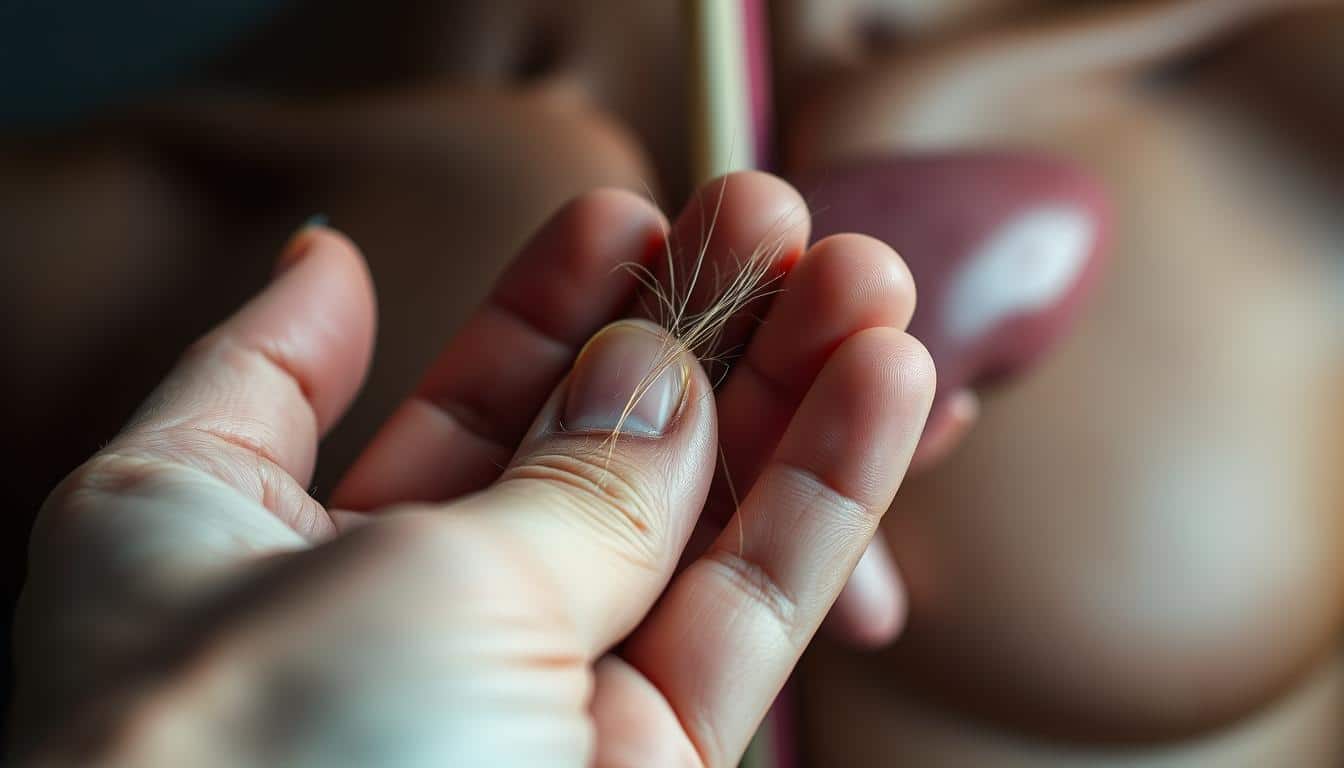If you’re noticing thinning strands or patchy areas, you might wonder how your health impacts your scalp. This article explores the relationship between blood sugar imbalances and reduced hair growth, backed by clinical research and expert insights.
High glucose levels can disrupt your body’s natural cycles, leading to weaker follicles over time. Both type 1 and type 2 variations of this condition may contribute to these effects through hormonal shifts, nutrient deficiencies, or impaired blood flow. We’ll break down how these processes work and why early intervention matters.
Later sections will cover actionable strategies to address these challenges, including FDA-approved treatments and lifestyle adjustments. All information reflects the latest medical guidelines to help you make informed decisions about your care.
Understanding this link isn’t just about aesthetics—it’s a window into your overall well-being. Let’s dive into the science behind these changes and what they mean for your health journey.
Understanding Diabetes and Its Impact on Your Body
Managing your well-being starts with knowing how blood sugar imbalances affect your body. Diabetes occurs when your system struggles to regulate glucose efficiently, leading to prolonged high or unstable levels. This condition primarily falls into two categories—type 1, where the immune system attacks insulin-producing cells, and type 2, marked by insulin resistance.
An Overview of Diabetes Types
Type 1 often develops early in life and requires insulin therapy. Type 2, more common in adults, links closely to lifestyle factors. Both forms disrupt normal blood sugar levels, which the American Diabetes Association recommends keeping between 80-130 mg/dL before meals. Uncontrolled glucose can damage blood vessels and nerves over time.
Common Symptoms and Complications
Early signs include fatigue, frequent thirst, and blurred vision. Over time, poor circulation may slow healing or cause numbness in extremities. These issues strain overall health and create a ripple effect—like reduced nutrient delivery to tissues. While not immediately obvious, such systemic stress can influence hair vitality indirectly.
Does Diabetes Cause Hair Loss
Metabolic imbalances may leave more than just internal marks—they can manifest in your hair’s health. Research shows chronic high blood sugar creates biological disruptions that directly affect follicle function. Two primary pathways explain this: immune responses and circulatory damage.
Exploring the Direct Connection
Persistent hyperglycemia weakens blood vessels, reducing oxygen supply to hair roots. A 2022 Journal of Investigative Dermatology study found glucose-damaged follicles enter resting phases prematurely, slowing growth cycles. This explains why regrowth often lags during unstable metabolic periods.
Type 1 conditions frequently coexist with autoimmune disorders like alopecia areata, where defenses attack healthy cells. Over 17% of patients with this dual diagnosis experience patchy hair loss, per NIH data. While not universal, it highlights how systemic inflammation impacts scalp health.
Managing these effects requires stabilizing glucose and addressing immune activity. Consult your care team if thinning coincides with other symptoms—early intervention improves outcomes. Remember, multiple factors influence hair vitality, but metabolic control remains a cornerstone.
How High Blood Sugar Levels Affect Hair Growth
Persistent glucose spikes don’t just strain your energy—they create structural changes that weaken your scalp’s foundation. When blood sugar levels remain elevated, proteins in hair follicles undergo glycation, stiffening their structure. This process starves roots of essential nutrients while accelerating oxidative stress.
Hyperglycemia and Damage to Hair Follicles
High blood sugar triggers inflammation that disrupts the growth-rest cycle. A 2023 Dermatology Research study found glucose-coated follicles produce 40% fewer keratinocytes—cells vital for strand strength. Over time, this leads to brittle strands that break easily. Damaged microvessels also limit waste removal, creating a toxic environment for hair follicles.
Reduced Blood Flow and Nutrient Delivery
Your scalp’s vascular network relies on steady blood flow to deliver oxygen and proteins. Chronic hyperglycemia thickens vessel walls, reducing circulation by up to 22% according to NIH data. Without adequate nourishment, follicles enter dormant phases faster. This explains why regrowth slows significantly during unstable metabolic periods.
Managing blood sugar levels helps reverse these effects. Stabilizing glucose preserves capillary integrity, ensuring nutrients reach hair roots efficiently. Pairing this with antioxidant-rich diets supports follicle recovery—proactive steps that protect both health and hair growth long-term.
The Role of Autoimmune Conditions and Hormonal Imbalances
Your body’s defense mechanisms and hormone regulation play critical roles in maintaining healthy strands. When these systems malfunction, they can disrupt natural processes—including those governing your scalp.

Alopecia Areata and Immune System Effects
Alopecia areata occurs when your immune system mistakenly targets hair follicles. This autoimmune condition often coexists with type 1 diabetes, as both involve similar inflammatory pathways. Research in the Journal of Clinical Endocrinology shows 24% of individuals with both conditions experience sudden patchy shedding.
Thyroid and Cortisol Influences on the Hair Cycle
Hormonal shifts—like thyroid dysfunction or chronic stress—alter the hair growth cycle. Elevated cortisol levels shorten the anagen (growth) phase, while thyroid imbalances prolong the telogen (resting) stage. A 2021 study found correcting these issues restored normal cycling in 68% of cases.
Diagnosing these conditions early allows targeted therapies. Blood tests measuring TSH or cortisol levels help identify hidden contributors. Addressing root causes—not just symptoms—supports lasting recovery for your scalp and overall health.
Recognizing Other Contributing Factors to Hair Loss
Multiple elements beyond glucose control influence scalp vitality. While metabolic health plays a role, external triggers like stress and prescription medications often compound shedding. Identifying these contributors helps create targeted solutions.
Stress and Hormonal Disruptions
Chronic stress elevates cortisol levels, shortening active growth phases. A 2023 Dermatology Times study found prolonged tension alters hormone ratios—increasing DHT production in susceptible individuals. This imbalance starves follicles of nutrients, worsening thinning patterns.
Prescription Drug Side Effects
Certain medications prescribed for related conditions may accelerate shedding. Beta-blockers, statins, and some antidepressants list telogen effluvium as a potential side effect. Always review treatment risk profiles with your doctor—adjusting dosages or switching formulas often resolves this.
Not all shedding directly causes hair loss through metabolic pathways. Environmental factors and treatment protocols interact uniquely in each case. Monitoring changes after starting new therapies provides actionable insights.
Practical ways to address these issues include stress-reduction techniques and medication reviews. Blood tests can reveal hidden hormonal imbalances, while scalp analyses pinpoint triggers. Partnering with healthcare providers ensures comprehensive care tailored to your needs.
Effective Treatment and Management Strategies
Addressing thinning hair requires a strategy that tackles both root causes and visible symptoms. Combining medical therapies with lifestyle adjustments offers the best path to restoring scalp health. Let’s explore proven methods to support regrowth while improving overall wellness.

Topical and Oral Medications Overview
Minoxidil (Rogaine) remains the gold standard topical treatment, stimulating follicles to extend growth phases. For men, oral medications like finasteride block hormones linked to pattern baldness. Always consult your doctor before starting these—they work best when paired with metabolic control.
Lifestyle and Nutritional Interventions
Antioxidant-rich diets combat oxidative stress damaging hair roots. Focus on leafy greens, berries, and nuts to improve blood flow. Omega-3 supplements and zinc-rich foods like oysters strengthen strand structure. Pair this with stress-reducing activities like yoga—chronic tension worsens shedding.
Managing Blood Sugar for Better Hair Growth
Consistently monitoring blood sugar levels protects follicles from glucose-related damage. Aim for fasting levels between 70-130 mg/dL and an A1C below 7%. Stable glucose ensures nutrients reach your scalp efficiently, creating ideal conditions for hair growth.
Regular checkups help refine your management plan over time. Work with specialists to balance treatments like platelet-rich plasma therapy with daily habits. Personalized approaches yield lasting results—your health journey is unique.
Preventative Measures for Supporting Healthy Hair Growth
Maintaining strong, resilient strands involves more than just topical treatments—it’s about holistic care. Simple adjustments to your daily routine can protect follicles while enhancing blood vessel function. Focus on strategies that reduce strain and optimize nutrient delivery.
Practical Hair Care Tips
Avoid tight ponytails or braids that pull on scalp tissue. Gentle combing with wide-tooth tools prevents breakage. Limit heat styling to twice weekly—excessive temperatures weaken keratin bonds.
Choose sulfate-free shampoos to maintain natural oils. These products cleanse without stripping moisture critical for follicle health. When drying, pat instead of rubbing to minimize friction damage.
Improving Circulation and Reducing Tension
Scalp massages boost circulation by 31% according to a 2023 dermatology trial. Use fingertips in circular motions for five minutes daily. Pair this with cardio exercises like brisk walking to enhance overall blood flow.
Antioxidant-rich foods like spinach support blood vessel elasticity. Omega-3s from walnuts reduce inflammation that hinders circulation. Stay hydrated—water transports nutrients to your scalp efficiently.
Consistent care prevents cumulative damage. Small, sustainable changes create environments where healthy strands thrive long-term.
Conclusion
Navigating health challenges often reveals unexpected connections between body systems. Unstable glucose levels disrupt natural growth cycles, weakening follicles through inflammation and poor blood flow. Autoimmune conditions like alopecia and hormonal shifts further complicate this process, accelerating shedding patterns.
Early intervention stabilizes blood sugar, slowing damage to delicate scalp tissues. Combined with targeted treatments, these steps address factors that cause hair loss and create environments where regrowth becomes achievable. Managing underlying causes—not just symptoms—yields lasting improvements in both metabolic health and hair vitality.
If you notice unusual thinning, consult a healthcare provider promptly. They can identify whether sugar imbalances, thyroid issues, or autoimmune conditions like alopecia contribute to changes. Diagnostic tests clarify root issues, enabling personalized solutions.
Proactive care empowers you to reverse setbacks. With consistent monitoring and evidence-based strategies, restoring healthy growth is within reach. Your journey toward balanced well-being starts with informed actions today.
FAQ
Can high glucose levels directly damage hair follicles?
Yes, consistently elevated blood sugar can harm follicles through glycation. This process stiffens blood vessels, reducing oxygen and nutrient delivery. Over time, weakened follicles may slow growth or shed hair prematurely.
How does poor circulation affect hair health in those with diabetes?
Impaired blood flow limits essential nutrients like iron and zinc from reaching the scalp. Weakened vessels also disrupt the natural growth cycle, leading to thinning or patchy areas.
Are autoimmune disorders linked to hair loss in people with diabetes?
Type 1 diabetes increases the risk of autoimmune conditions like alopecia areata. The immune system mistakenly attacks follicles, causing sudden round patches of shedding. Thyroid imbalances—common in diabetes—can also trigger shedding.
Can stress worsen hair loss when managing diabetes?
Chronic stress raises cortisol levels, which disrupts the hair cycle and worsens insulin resistance. This double impact accelerates shedding, often pushing follicles into a prolonged resting phase (telogen effluvium).
Do diabetes medications contribute to thinning hair?
Some drugs, like insulin or statins, list hair loss as a rare side effect. However, uncontrolled glucose poses a greater risk. Always consult your doctor before adjusting prescriptions—they may recommend supplements or alternative treatments.
What strategies support regrowth while managing blood sugar?
Focus on steady glucose control through diet and exercise. Topical minoxidil can stimulate follicles, while biotin supplements strengthen strands. Avoid tight hairstyles and heat tools to minimize breakage during regrowth.
How can scalp care improve hair density with diabetes?
Gentle massages boost circulation, and sulfate-free shampoos prevent dryness. Consider laser therapy or corticosteroid injections for stubborn patches. Prioritize protein-rich meals and omega-3s to nourish follicles from within.


